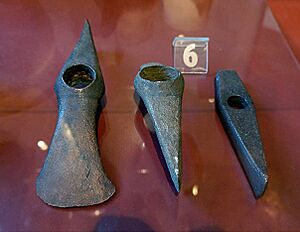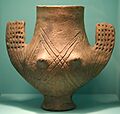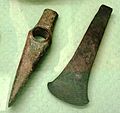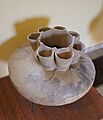Baden culture facts for kids
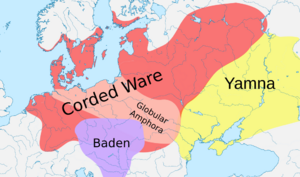 |
|
| Geographical range | East-Central Europe |
|---|---|
| Period | Chalcolithic, Bronze Age |
| Dates | c. 3600–2690 BC |
| Major sites | Vucedol |
| Preceded by | Lengyel culture, Bodrogkeresztúr culture, Coțofeni culture, Cernavodă culture, Funnelbeaker culture, |
| Followed by | Vučedol culture, Bell Beaker culture |
The Baden culture (also called Baden-Pécel culture) was an ancient group of people. They lived in parts of Europe during the Chalcolithic (Copper Age). This was a time when people started using copper tools. The Baden culture existed from about 3520 BC to 2690 BC.
You can find traces of the Baden culture in Central and Southeast Europe. This includes countries like the Czech Republic, Romania, Hungary, Poland, Slovakia, Croatia, and Austria. Some pottery from the Baden culture has even been found in Germany and Switzerland. Sometimes, the Baden culture is talked about together with the Coțofeni culture. This is then called the Baden-Coțofeni culture.
Contents
Learning About the Baden Culture
The Baden culture got its name from a place called Baden near Vienna. An Austrian expert named Oswald Menghin gave it this name. It is also sometimes known as the Ossarn group or Pecel culture.
Many experts have studied this ancient culture. One of the first detailed studies was written by J. Banner in 1956. Other important researchers include E. Neustupny and Vera Nemejcova-Pavukova.
When the Baden Culture Lived
The Baden culture grew out of an older group called the Lengyel culture. This happened in the western Carpathian Basin. Experts believe it also got ideas from other cultures in the southeast. These include the Ezero culture and the Cernavodă culture.
The Baden culture lived at roughly the same time as other ancient groups. These include the late Funnelbeaker culture and the early Corded Ware culture. The Baden culture had different stages over time. These stages include Balaton-Lasinya, Boleráz, Post-Boleráz, and Classical Baden.
How They Lived
Before the Baden culture, no single group lived across the whole Carpathian Basin. But the Baden culture spread widely across this area. This shows it was a large and united group of people.
Archaeologists have found interesting things about their settlements. In some places, a larger building was built in the center. Special decorations were also found in some burial sites. These findings might mean that some people had more power or importance in their society.
Some settlements were very large, but people might have only lived there for part of the year. This could explain why so many settlements are linked to the Baden culture. However, some settlements were built on hilltops and were fortified. These places were likely lived in all year round and acted as important centers.
Their Way of Life
The Baden people had a mixed economy. This means they did many things to get food and resources. They practiced full-scale agriculture, growing crops for food. They also kept many kinds of farm animals. These included pigs, goats, and cattle.
The Baden culture is famous for having some of the earliest models of wagons or carts made from pottery. These models sometimes even had handles. Archaeologists have also found burials of pairs of cattle. Some experts think these cattle were used to pull wagons. Even though no actual wagons have been found, these clues suggest that the Baden people used wheeled vehicles.
Burial Customs
The Baden people buried their dead in different ways. They sometimes buried bodies whole (inhumations). Other times, they burned the bodies (cremations). In places like Slovakia and Hungary, the burned remains were often put into special pots. These pots were shaped like people (anthropomorphic urns).
At a site called Nitriansky Hrádok, a large grave with many bodies was found. They also buried cattle, perhaps showing how important these animals were.
Gallery
Genetic Studies
Scientists have studied the DNA from the remains of fifteen people from the Baden culture. These people lived between 3600 and 2850 BC. The studies looked at their Y-DNA (passed down from fathers) and mtDNA (passed down from mothers).
The results showed that most of the Baden people had ancestry from "Early European Farmers." A smaller part of their ancestry came from "Western Hunter-Gatherers." Only a very small amount, if any, came from "Western Steppe Herders." This suggests that new ideas, like language, might have spread more through culture than by large groups of new people moving in.
See also
- Prehistoric Europe
- Ezero culture
- Coțofeni culture
- Prehistory of Transylvania
- Vučedol culture




